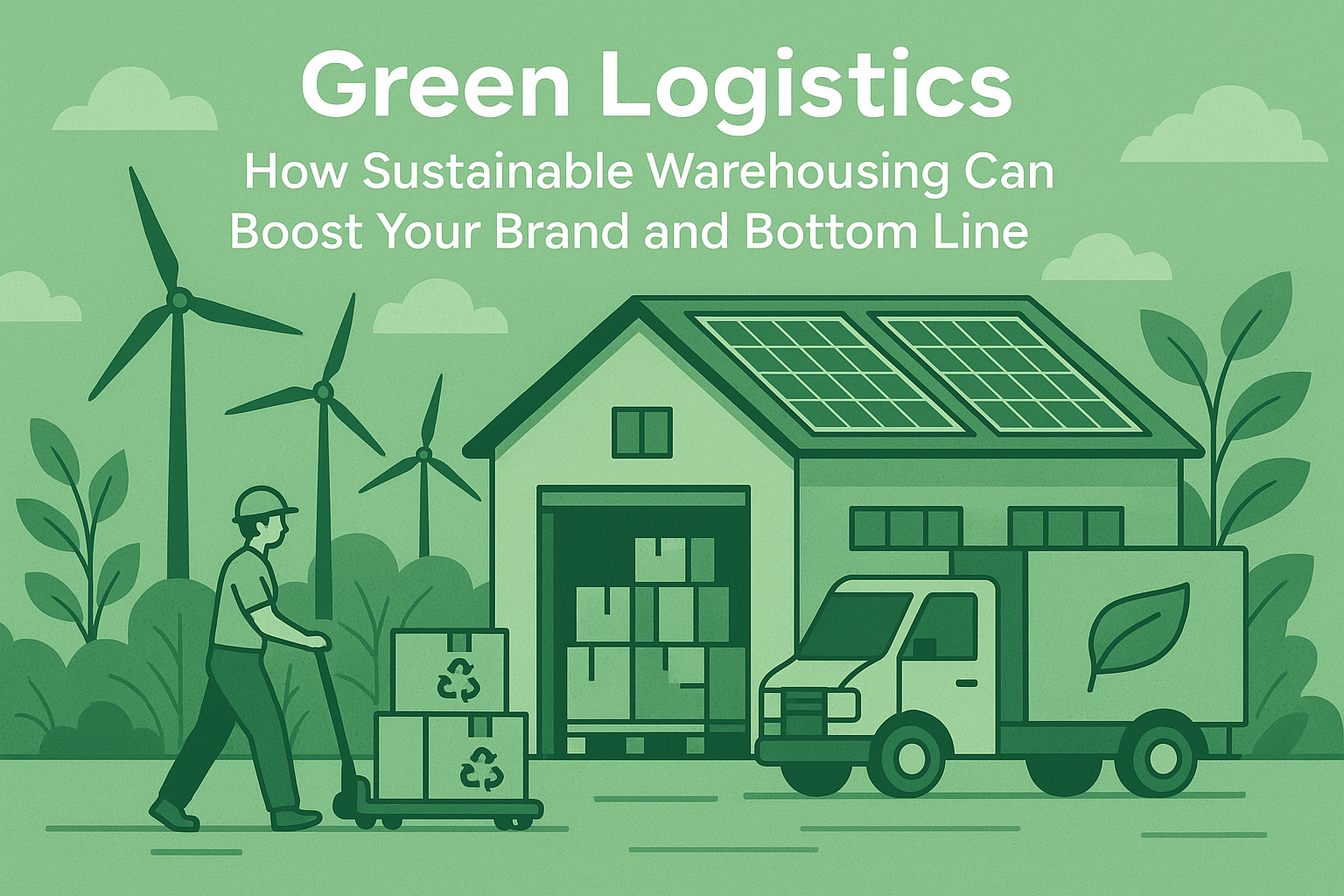In today’s fast-paced e-commerce world, consumers and businesses are increasingly prioritizing sustainability. From the products they buy to the companies they support, a brand’s environmental footprint is under scrutiny. This shift is not just a trend; it’s a fundamental change in how businesses operate. So, how can your brand not only meet these expectations but also gain a competitive edge? The answer lies in green logistics, particularly through sustainable warehousing practices.
Sustainable warehousing, also known as green warehousing or eco-friendly logistics, involves implementing operational strategies and technologies to reduce the environmental impact of a warehouse or distribution center. It’s a holistic approach that goes beyond simple recycling, integrating energy efficiency, waste reduction, and ethical labor practices to create a more responsible and efficient supply chain.
Why Sustainable Warehousing is More Than a Trend: A Strategic Imperative
Embracing sustainable warehousing isn’t just about being a good corporate citizen. It’s a smart business decision that directly impacts your brand’s reputation, operational costs, and bottom line. The benefits are multifold, creating a ripple effect that extends from your warehouse floor to your customer’s doorstep.
1. Enhanced Brand Reputation and Customer Loyalty
Today’s consumers, particularly Gen Z and Millennials, are willing to pay more for sustainable products and support eco-conscious brands. A recent study by IBM found that 70% of consumers believe it’s important for a brand to be sustainable or environmentally friendly. By actively promoting your green logistics efforts, you can:
- Attract new customers who align with your values.
- Build trust and loyalty with your existing customer base.
- Differentiate your brand in a crowded marketplace.
Imagine a customer choosing between two similar products. If one brand openly shares its commitment to sustainable logistics, using solar-powered warehouses and eco-friendly packaging, which one do you think they’ll choose? The answer is clear.
2. Significant Cost Savings and Increased Efficiency
Going green often means being lean. Sustainable practices are inherently tied to efficiency, which translates into real financial savings.
- Energy Reduction: Implementing LED lighting, smart thermostats, and renewable energy sources like solar panels drastically cuts electricity bills.
- Waste Management: Reducing packaging waste, optimizing material use, and implementing robust recycling programs lower disposal costs.
- Operational Optimization: Efficient routing, optimized picking paths, and proper inventory management reduce fuel consumption and labor costs.
These savings can be reinvested into your business, allowing for growth and further innovation. This is a topic we’ve delved into before in our article on warehouse and storage solutions, which highlights how modern warehousing can drive efficiency.
3. Reduced Environmental Footprint
This is the core of sustainable warehousing. By minimizing your environmental impact, you contribute to a healthier planet. Key areas of focus include:
- Carbon Emissions: Reducing energy consumption and optimizing transportation routes to lower greenhouse gas emissions.
- Waste Diversion: Minimizing landfill waste by recycling, reusing materials, and composting.
- Water Conservation: Implementing water-efficient fixtures and systems.
These actions are crucial for meeting global sustainability targets and future-proofing your business against evolving environmental regulations.
Key Pillars of Sustainable Warehousing: A Comparative Analysis
Adopting a green logistics strategy requires a multi-pronged approach. Below, we compare traditional warehousing practices with their sustainable counterparts to highlight the most impactful changes.
| Aspect | Traditional Warehousing | Sustainable Warehousing | Benefits of Sustainable Approach |
|---|---|---|---|
| Energy | High-intensity discharge (HID) lighting, manual temperature control, reliance on grid power. | LED lighting, smart building management systems, solar panels, and wind turbines. | Significant reduction in electricity costs, lower carbon footprint, and energy independence. |
| Transportation | Inefficient routing, half-empty trucks, reliance on fossil fuels. | Optimized routing (route planning software), consolidated shipments, use of electric or alternative fuel vehicles. | Reduced fuel costs, lower emissions, faster delivery times. |
| Packaging | Excessive plastic and cardboard, non-recyclable materials. | Minimalist design, recycled/biodegradable materials, right-sized boxes, reusable packaging. | Reduced waste disposal costs, enhanced brand image, and improved customer experience. |
| Waste Management | Minimal recycling, sending all waste to landfills. | Comprehensive recycling programs, waste-to-energy initiatives, composting organic waste. | Lower waste management costs, compliance with regulations, and positive community relations. |
| Technology | Manual inventory systems, paper-based processes. | IoT sensors, AI-driven automation, cloud-based WMS for real-time data and optimization. | Increased efficiency, reduced errors, and data-driven insights for continuous improvement. |
Case Study: A Retailer’s Journey to Green Logistics
Let’s consider a fictional e-commerce brand, “EcoGoods,” specializing in sustainable home products. Initially, EcoGoods used a traditional 3PL partner with standard warehousing practices.
Challenge: EcoGoods was facing high operational costs due to inefficient energy use and excess packaging. Their customers, who were highly eco-conscious, were also starting to question the brand’s supply chain practices on social media, leading to a potential reputational risk.
Solution: EcoGoods partnered with a new 3PL provider that specialized in green logistics, much like our own fulfillment services. The partnership focused on three key areas:
- Energy Efficiency: The new warehouse was equipped with motion-sensor LED lights and a solar panel system, reducing energy consumption by 40%.
- Smart Packaging: They implemented “right-size” packaging software to ensure each order was shipped in the smallest possible box, reducing cardboard usage by 25%. They also switched to biodegradable packing peanuts.
- Optimized Transportation: The 3PL used advanced route optimization software to consolidate shipments and reduce fuel consumption for last-mile delivery.
Result: Within one year, EcoGoods saw a 15% reduction in their overall logistics costs. More importantly, their brand image as a truly sustainable company was solidified, leading to a 30% increase in new customer acquisition. The positive feedback on social media and a featured article in a leading industry magazine validated their strategic shift.
Actionable Steps to Implement Green Warehousing
Ready to start your journey? Here are some actionable steps your brand can take, regardless of size.
1. Conduct a Sustainability Audit
Before you can improve, you need to know where you stand. Partner with a logistics expert to assess your current energy consumption, waste production, and transportation efficiency. This audit will provide a baseline and identify key areas for improvement.
2. Partner with a Green 3PL Provider
For many businesses, the most efficient way to implement green logistics is by partnering with a third-party logistics (3PL) provider that has already made the investment. When evaluating potential partners, ask about their:
- Renewable energy sources.
- Waste diversion and recycling programs.
- Use of energy-efficient equipment.
- Technology for route optimization and inventory management.
Our network of fulfillment centers, including our Texas fulfillment and warehouse services, is designed with these principles in mind.
3. Optimize Your Packaging Strategy
Packaging is a highly visible part of your supply chain. Focus on:
- Reducing empty space (air) in your packages.
- Using recycled or sustainably sourced materials.
- Offering “eco-friendly” packaging options at checkout.
4. Leverage Technology for Efficiency
Technology is the engine of modern green logistics. Invest in or partner with a provider that uses a robust Warehouse Management System (WMS) to optimize every part of the process, from inventory tracking to picking and packing. Real-time data allows for continuous improvement and waste reduction.
—
Frequently Asked Questions (FAQ) about Green Logistics
What is the difference between green logistics and sustainable logistics?
The terms are often used interchangeably, but “sustainable logistics” is a broader concept. Green logistics primarily focuses on the environmental impact (e.g., reducing carbon emissions, waste). Sustainable logistics includes the environmental aspect but also considers social and economic factors, such as ethical labor practices, employee well-being, and long-term economic viability. Green logistics is a key component of a truly sustainable supply chain.
How can small businesses afford to implement sustainable warehousing?
While large-scale investments can be costly, small businesses can start with incremental changes. Focus on low-cost, high-impact actions like recycling programs, using recycled packaging, and optimizing delivery routes. The most effective strategy is often partnering with a 3PL provider that has already invested in sustainable infrastructure, allowing you to benefit from their economies of scale without the upfront capital expenditure.
Does sustainable warehousing slow down the fulfillment process?
On the contrary, sustainable practices often lead to increased efficiency. For example, using a modern Warehouse Management System (WMS) to minimize travel time for order picking not only reduces energy consumption but also speeds up the fulfillment process. The goal is to eliminate waste in all forms—including wasted time and resources—which ultimately benefits both the planet and your bottom line.
—
Conclusion: Your Path to a Greener, More Profitable Future
The convergence of consumer demand, economic pressures, and environmental urgency has made sustainable warehousing a non-negotiable part of modern business strategy. It’s not about making a single choice; it’s about a continuous commitment to improvement that affects every aspect of your supply chain.
By implementing these principles, whether through internal initiatives or by partnering with a dedicated 3PL like WarehouseTX, you can build a more resilient, efficient, and reputable brand. The investment you make in green logistics today will pay dividends for years to come, securing your place in a future where profitability and sustainability go hand in hand.

